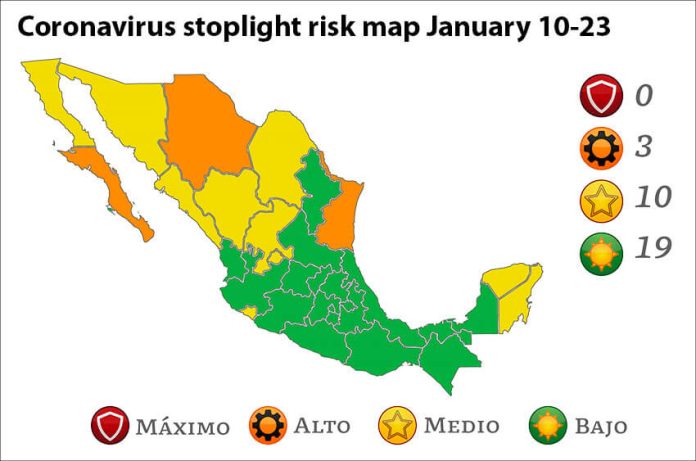Thirteen of Mexico’s 32 states are high risk orange or medium risk yellow on the federal government’s latest coronavirus stoplight map, while active case numbers are at an all-time high as the highly infectious omicron strain spreads rapidly.
There are three orange states on the new map – which takes effect Monday and will remain in force through January 23, 10 are painted yellow and 19 are low risk green.
Tamaulipas and Baja California Sur jumped to orange from green while Chihuahua regressed to that color from yellow.
The yellow states are Aguascalientes, Baja California, Sonora, Coahuila, Colima, Quintana Roo, Yucatán, Sinaloa, Durango and Zacatecas. The first three were already yellow while the last seven switched to yellow from green.
The updated map is indicative of a coronavirus situation that has deteriorated quickly in recent days – at least in terms of new infections. There were no orange states on the previous map and just four yellow ones.
The Health Ministry reported more than 20,000 new cases on each of Wednesday, Thursday and Friday last week before the daily tally exceeded 30,000 for the first time ever on Saturday.
An additional 30,671 confirmed infections on Saturday and 11,599 on Sunday lifted Mexico’s accumulated case tally to 4.12 million. There are currently 158,332 estimated active cases across the country, more than at any other time of the pandemic.
Baja California Sur has the highest number of active cases on a per capita basis followed by Mexico City, Quintana Roo, San Luis Potosí and Zacatecas.
The official COVID-19 death toll passed 300,000 on Friday and now stands at 300,334, the fifth highest total in the world.
An average of 16,185 cases were reported per day during the first nine days of January – a whopping 446% increase compared to the daily average in December, but fatalities have declined almost 40% to an average of 101 per day.
The sharp increase in new cases – the majority are presumed to be omicron infections – has not translated into a significant increase in hospitalizations, with just 19% of general care COVID beds and 12% of those with ventilators occupied as of Friday.
![]()
However, occupancy rates are much higher in some states such as Quintana Roo and Baja California, where more than 60% of general care beds are taken. Aguascalientes has the highest occupancy rate for beds with ventilators, with 59% currently in use.
In other COVID-19 news:
• There has been a slight increase in hospitalizations in Mexico City, Mayor Claudia Sheinbaum said Sunday.
However, the pressure on the health system in the capital is much lower than that exerted during the second and third waves of infections, she said.
The mayor said the high vaccination rate in Mexico City and the characteristics of the omicron variant – which causes less severe disease – have helped keep hospitalizations low compared to previous waves.
There were just under 700 patients in COVID wards in Mexico City hospitals on Saturday, of whom 134 were in intensive care. Federal data shows that 37% of general care beds and 10% of those with ventilators are occupied in the capital.
Coronavirus spokesman Eduardo Clark said that 70% of hospitalized patients are not vaccinated. He also said that it’s not “exceedingly necessary” for people with COVID-like symptoms to get tested.
“People with symptoms have to isolate themselves, getting tested is not necessary. If we have any respiratory symptom, we should assume that it’s COVID, go home and stay isolated for seven days,” Clark said.
Sheinbaum made similar remarks, asserting that “it’s not necessary to go and get tested at this time.”
Their advice comes as demand for COVID testing soars across the country.
• Mayor Sheinbaum announced that booster shots for adults aged 50 to 59 will be available in Mexico City from January 18.
The federal government started offering booster shots to people aged 60 and over last month, but seniors are still waiting for them in some parts of the country.
People aged 40 and over can register to receive a booster shot on the government’s vaccination website.
• Mexico has recorded its first confirmed case of “flurona” – a concurrent infection with COVID-19 and influenza. The case was detected in a 28-year-old woman in Tepic, Nayarit, state Health Minister José Munguía said.
• President López Obrador said he would get tested for COVID after waking up “hoarse” on Monday morning.
“I woke up hoarse, I’m going to get tested later but I think it’s the flu,” he told reporters at his regular news conference.
López Obrador acknowledged Friday that he had been in contact with Economy Minister Tatiana Clouthier, who announced earlier the same day that she had tested positive.
With reports from El Universal, Reforma and Milenio
